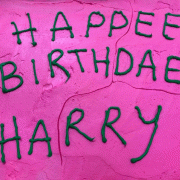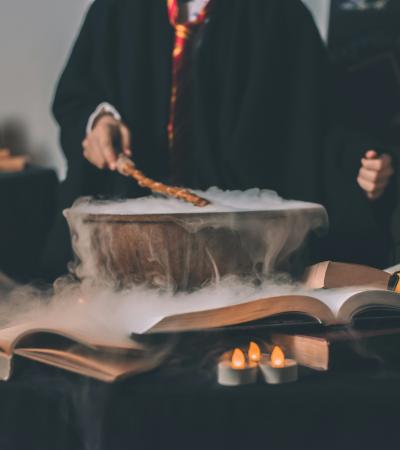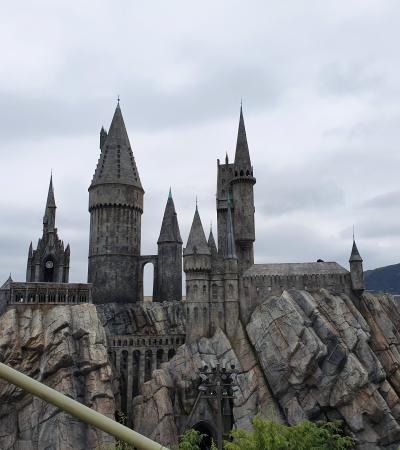Harry Potter-themed events for adults do really well at our library. Previously we have had Harry Potter Trivia Nights, DIY Harry Potter Crafts and a Harry Potter Escape Room.
We wanted to continue this magical tradition with a new type of program, and Harry Potter Bingo was the winner. Our goal for this program was for adults to view the library as a place to connect and engage with other community members.
Advanced Planning
Our first step was generating the Bingo cards. There are a lot of free Bingo generator programs out there, but most of them limit how many cards can be generated per batch.
In the end, I used Bingo Baker and decided to purchase a lifetime membership for the very reasonable rate of $14.95. This enabled me to be able to create 100 Bingo cards per batch and gave me the option to randomly generate call lists so there was no need to create the traditional Bingo balls or call cards for each round.
I created different themes of Bingo cards so that we could have several rounds. I generated cards for Harry Potter Characters, Library, and Spells and Charms. (See sample Bingo cards and call lists under Attachments)
We also purchased prizes in advance. Depending on your budget you could do a prize for each round or do a raffle at the end of the night. We decided to buy a prize for each round, purchasing Harry Potter Funko Pops, Harry Potter UNO, Luna Lovegood’s Spectre Specs and a few Harry Potter books.
Marketing
We promoted this program in a variety of ways, including posting in-house fliers and posters about two months prior to the event, and using social media and monthly email newsletters.
The most successful form of marketing was word of mouth. At our spring Harry Potter Trivia Night, we mentioned the dates and times for upcoming Harry Potter events. Planning in advance and having similarly themed events every other month or once a quarter made it easy to verbally tell our target audience about upcoming events of interest to them.
Budgeting
Costs associated with this program can vary and be tailored based on your budget. I purchased a lifetime membership with Bingo Baker for $15. This expense saved a lot of time generating the Bingo cards.
Prizes can be purchased or solicited through donations. For example, the Harry Potter book prizes were gently used and donated to our Friends of the Library. We spent about $50 total on other prizes, including the Funko Pops, Uno game and Spectre Specs.
An additional $40 was spent on iBngo chips. We decided to purchase Bingo chips so we could easily reuse the Bingo cards. We only had to print each round of Bingo cards once but used two of the rounds twice. Depending on your printing and paper budget, you will need to factor in printing the various rounds of Bingo cards as well.
Our final expense was refreshments. We are able to serve treats as long as they are purchased. Since July 31 is Harry Potter's birthday, we splurged for a "Happee Birthdae Harry" cake for another $50. (See the finished product under Photo Slideshow.)
This program can easily be replicated for less than $100 with no refreshments, using donated prizes and forgoing the Bingo chips.
Day-of-event Activity
A few hours before the event, two library pages set up 17 tables with six chairs at each table.
Two hours before the event one librarian began setting out the different rounds of Bingo cards and Bingo chips on each table. On each table were 18 Bingo cards — one card for each of the three different Bingo rounds, with six people at each table.
Program Execution
We had two staff members running the program as well as one volunteer to assist. We had 74 attendees for the event.
Our senior library technician is a huge Harry Potter fan and was the caller. She began each round by stating which card we were using and the pattern players needed to win. We did a variety of Bingo patterns including row, corners, cross or "T", blackout and an "H" for Harry. Using one of the randomly generated call list she began calling out the books, characters or spells for each round.
The winner was decided by who yelled Bingo first. The second staff member went to see the Bingo card as the attendee called out the squares. If they were right, and it was confirmed by the staff member, they were the round winner.
The winner of each round got to choose which prize they wanted. The second staff member also collected the past Bingo cards, shuffled them and redistributed them for future rounds.
We received a lot of really positive feedback. The caller also asked if everyone had a good time, and we received a resounding "yes" from the attendees.
Advice
My advice would be to stay organized. When using the random call list, make sure to clearly set aside the used ones. One round we almost used the same call list twice because it was placed back on the table.
Also decide on the patterns you will use ahead of time and for which iBngo cards they would work best. The Library and the Spells and Charms rounds have fewer boxes (29 total) than the characters cards (44 total). We used the Library round for the blackout pattern (where all the squares must be filled), which could have gone badly. We were getting close to the end of the random call list and were worried five or six attendees would call bingo at the same time. Luckily we only had two call Bingo and one clearly said it first.
My final advice would be use your staff resources wisely. Our caller was amazing. She was funny, engaging and knew her Harry Potter trivia. Just calling out the words or spells may not be very engaging. She had the audience laughing and calling back answers to random challenges such as: “Whoever knows what this spell does receives house points!”
Supporting Materials
- Feedback (Coming Soon!)
- Programming Librarian Facebook Group




